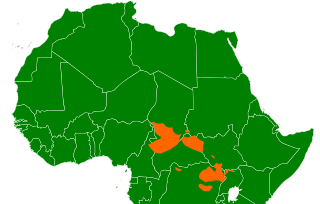Related Research Articles
The Fer language, also Dam Fer or Fertit, one of several languages called Kara, is a Central Sudanic language spoken by some five thousand people in the northern Central African Republic near the Sudanese and Chadian borders, in the region known as Dar Runga.

The Sultanate or Kingdom of Bagirmi or Baghermi was a kingdom and Islamic sultanate southeast of Lake Chad in central Africa. It was founded in either 1480 or 1522 and lasted until 1897, when it became a French protectorate. Its capital was Massenya, north of the Chari River and close to the border to modern Cameroon. The kings wore the title Mbang.
The Gula Iro language is a Bua language spoken by some 3,500 people north and east of Lake Iro in southern Chad, between the Bola and Salamat rivers. It has four dialects, according to Pairault:

Central Sudanic is a family of about sixty languages that have been included in the proposed Nilo-Saharan language family. Central Sudanic languages are spoken in the Central African Republic, Chad, South Sudan, Uganda, Congo (DRC), Nigeria and Cameroon. They include the pygmy languages Efé and Asoa.
The Sara languages comprise over a dozen Bongo–Bagirmi languages spoken mainly in Chad; a few are also spoken in the north of the Central African Republic. They are members of the Central Sudanic language family. Greenberg (1966) treats all varieties as dialects of a Sara language, whereas Tucker and Bryan (1966) consider the Sara to be a dialect cluster of several languages. Most members of the different Sara languages/dialects consider their speech form distinct languages, but there is currently insufficient language information to determine which speech varieties need to be considered distinct languages, and which are dialects of other languages.

Chad has two official languages, Arabic and French, and over 120 indigenous languages. A vernacular version of Arabic, Chadian Arabic, is a lingua franca and the language of commerce, spoken by 40–60% of the population. The two official languages have fewer speakers than Chadian Arabic. Standard Arabic is spoken by around 615,000 speakers. French is widely spoken in the main cities such as N'Djamena and by most men in the south of the country. Most schooling is in French. The language with the most first-language speakers is probably Ngambay, with around one million speakers.
Sara language may refer to:
Banda is a family of Ubangian languages spoken by the Banda people of Central Africa. Banda languages are distributed in the Central African Republic, Democratic Republic of the Congo, and South Sudan.
Buyang is a Kra language spoken in Guangnan and Funing counties, Yunnan Province, China by the Buyang people. It is important to the reconstruction of the hypothetical macrofamily Austro-Tai as it retains the disyllabic roots characteristic of Austronesian languages. Examples are "to die", "eye", "head", and "eight".
Miltu is an endangered Afro-Asiatic language spoken in southwestern Chad, in villages along the Chari River in the area of Bousso. A 1993 census reported 270 speakers. Speakers are shifting to Bagirmi.
The Bongo–Bagirmi or Sara–Bongo–Bagirmi languages are the major branch of the Central Sudanic language family with about forty languages. Principal groups include Bagirmi languages such as Naba and the Sara languages. They are spoken across CAR, Chad, South Sudan, and adjacent countries.
The Kara languages are Tar Gula and possibly related Central Sudanic languages of the Central African Republic. The name Kara is used for numerous other peoples of the region, and so is often ambiguous.
Doba is a Central Sudanic language of Chad. It is traditionally considered three languages, because it is spoken by three ethnicities with separate identities, the Bedjond, the Mango, and the Gor. However, all have a high degree of mutual intelligibility, and so by that standard are a single language.
Shemya is the language of the Sinyar people. It is a Central Sudanic language spoken in Chad and formerly in Darfur, Sudan. It is variously spelled Shamya, Shamyan, Shemya, Sinya, and known as Symiarta, Taar Shamyan, Zimirra.
Yulu is a Central Sudanic language spoken by the Yulu people of South Sudan and the Central African Republic (CAR). It has an estimated 7,000–13,000 speakers.
The Gula'ala language is spoken just off Malaita Island in the Solomon Islands.
Kenga is a Bongo–Bagirmi language of Chad. Speakers make up the majority of the population in Kenga canton in Bitkine sub-prefecture.
Gula is a Bongo–Bagirmi language of Chad.